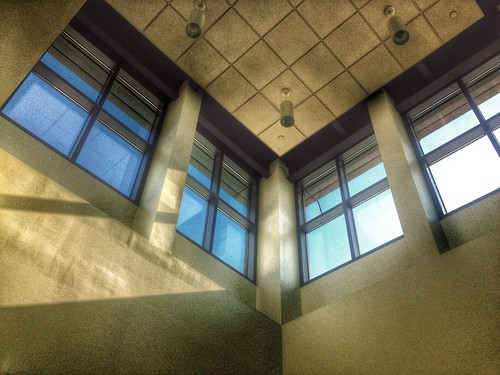
creative commons licensed ( BY-SA ) flickr photo shared by cogdogblog
For a break today, my first full day on campus at Thompson River University, I do the thing I enjoy most– wandering around with my camera.
I do cite a subtle and maybe overlooked tip for photography is “to look for the light.” This means much more than conventional wisdom of having your back to light sources, which often does work to best light a subject outdoors. But there is just as much beauty in breaking that, taking photos directly into the light, or using strong side lighting.
But I’d been thinking about something I probably operate at a more instinctual level, from experience with the camera, there is a feeling when I am in certain places, or noticing the way light is highlighting vividly, or when it is absent, or when shadows and light have interplay. I cannot pinpoint it, but its a gut feeling in those moments that there is interesting light at work. And that means I then amplify my awareness and look more intently as to where I might find it.
You see, most of photography is done by figuring out how to remove most of what you see, that is composition by cropping out with just the camera view finder.
The photo above was taken in a non descript location, the stairwell of the building Gardner Campbell works in at Virginia Commonwealth University. But when I looked up, as I tend to do, and scan around me, I got that feeling from the way the light was coming in the windows, the geometries of the elements, the shadow on the wall… it told me that maybe there was an interesting photo in that place.
I am seeing this now at almost 5pm in the student union, I am looking at the vivid last daylight strike a vivid streak across the valley, lighting up the city of Kamloops at the based of dark brooding mountains. There is a photo there (well actually it was better yesterday):
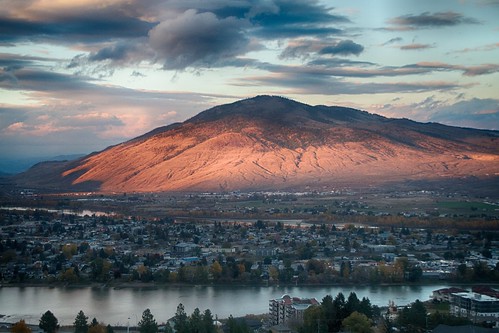
creative commons licensed ( BY-SA ) flickr photo shared by cogdogblog
I am not writing this just to whaffle about photography techniques, though I do really enjoy myself writing about the thoughts behind a photo as much as I like reading about the ideas of others, like Tom Woodward wrote last night on his photo of a couple’s kiss with a dog in front of a 7-11:
I was actually trying to shoot the dog here and the kiss started. The camera was extended at arms length and nearly on the ground. As a result, I wasn’t sure I’d got the shot until I looked later. You don’t often see zombies kissing so that was pretty fortuitous. The whole image tells a pretty interesting story with 7-11, cigarette ads, that big guy in the corner … it’s another version of Americana.
Photography is more than just snapping photos, damnit. Well to me it is.
But I have been noodling if there is a similar process at work when swimming among the firehose of information in a space like Connected Courses or the whole damn web in general. Is there a sense you get when just scanning, of something like “good” or “interesting” light in photography that takes you to interesting ideas?
Is it a clever title? a turn of a phrase? a provocative link? a vague link that does not indicate where it goes? The familiarity of the source url or the curiousness of it? What are the suggestions in the flow that help you clue in to what tends to be more interesting than not?
Because, I conjecture, if you can hone your senses for seeing nuanced suggestions of good/worthy/intriguing ideas out there in the information flow, you can get much more out of it than just getting soaked.
I don’t know. Play along with me. Tell me what clues your senses, if you really do have an attention span less than a goldfish, how well do you use it?
@cogdog wondering what u think of the "fact" mentioned around minute 1:50-1:57 (HT @taniatorikova blog): http://t.co/13SRy5Br8b #ccourses
— ℳąhą Bąℓi مها بالي (@Bali_Maha) October 27, 2014
What I do know is my photos.
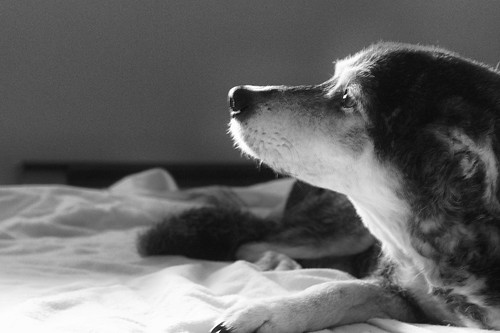
creative commons licensed ( BY-SA ) flickr photo shared by cogdogblog
Visiting my friends Brian and Keira was special too for the opportunity to take photos of their dog Dexter, a super canine creature who was defied death and defeat more times than one can count. He does seem to avoid the camera, but I spotted him laying on a mattress in a room; there was a sharp light coming in a window that was sharp on his front, leaving the back in the dark.
I was pretty sure there was a good photo in this space.
So yes, pay attention to not just the bright ideas, but also the vaguer shadows, and their intersections.

creative commons licensed ( BY-SA ) flickr photo shared by cogdogblog
The mixture of vivid light and dark shadows of leaves on the Administration Building at Chico State University called to me. This combined with the regality and suggestion of what an edifice suggests speaks loudly too as a metaphor.
Among the information flow, I try to look for things that are representative or suggestive of other ideas outside their same domain.
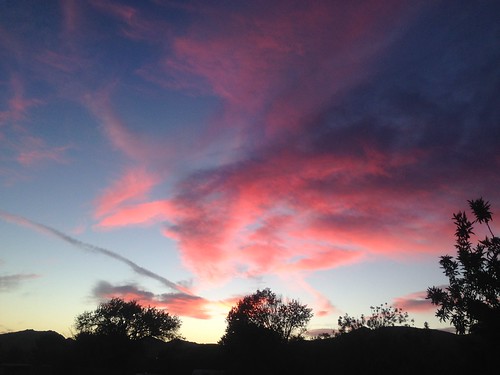
creative commons licensed ( BY-SA ) flickr photo shared by cogdogblog
Obviously sunsets like this one over Beatty Nevada loudly yell as a photo opportunity, but a sky by itself is detached. By having the foreground elements of palm trees and desert shrubs, and letting them become silhouettes by exposing the shot for the sky works here. Well, to me. This is a deliberate action when I took the shot to use the foreground.
How to we use foreground to shape perspective on ideas? Is it working with near and far? Is it thinking about the big picture and the practical? Grab a metaphor, any metaphor.
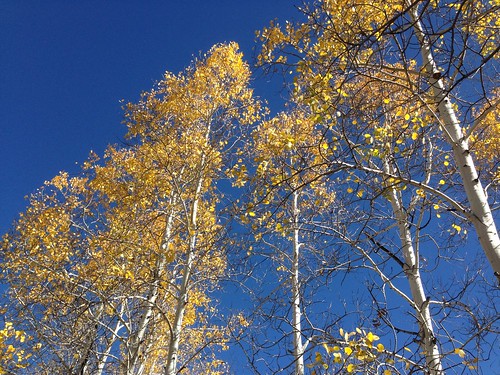
creative commons licensed ( BY-SA ) flickr photo shared by cogdogblog
The brief yellow glory of aspen trees in the mountain slopes of Flagstaff as easy to see. But I tossed maybe 5 other shots because the angle did not catch the color or the framing was wrong. Looking up against the Arizona sky accentuates the deep blueness of the sky. People elsewhere buy polarizing filters to get this effect, we get it in Arizona for free.
With ideas, it helps just to look in different directions that straight on.
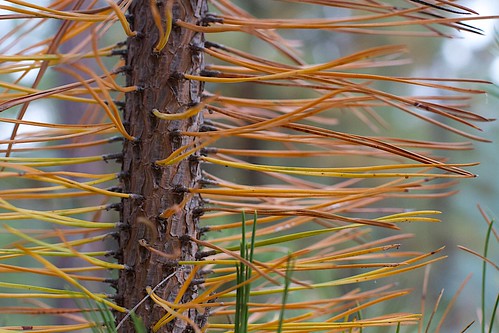
creative commons licensed ( BY-SA ) flickr photo shared by cogdogblog
These tawny pine needles in a tree n my home in Arizona yelled out at me too. This is not vivid sharp light, but it was the kind that makes the colors pop, especially in contrast with the trunk and the green matte background of the trees. It might not have worked against the dulled sky. Choosing a dark background for a shot where the aperture is wide open makes a world of difference.
Or think about focussing on a key detail, or paying attention in a way that Gardner Campbell teaches us, to zone in not on the whole forest, but the nugget that moves us.

creative commons licensed ( BY-SA ) flickr photo shared by cogdogblog
I always look for light and patterns in reflections like in these buildings in downtown Auckland. You have to move around often to see how things change or overlap. They present mirror worlds and juxtapose objects and often mix the light in unexpected ways. I focus much on buildings in dense urban environments but just as much on puddles in the forests, a rear view mirror out a car window, water on a lake.
Likewise look for interesting patterns in ideas that reflect off of other ones.

creative commons licensed ( BY-SA ) flickr photo shared by cogdogblog
You can get interesting photos in crappy light, as this dark and stormy day at Ragland Beach. The shadowy figure of my friend Nigel’s son, the lines of water, and the vague boundaries of the clouds work for me (yes some of this is done with photo editing). But you can get great mood setting photos in poor light.
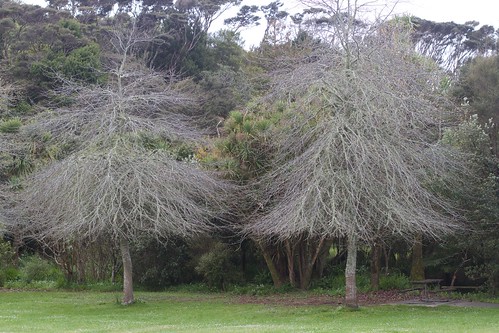
creative commons licensed ( BY-SA ) flickr photo shared by cogdogblog
More flat light on these trees at the park near this beach. I went for this because the light had a softness on the trees and as much for the symmetry of the shape. Again, it’s not textbook lighting. Don’t leave your camera at home just because it is a cloudy day. Don’t dismiss ideas in places you may not expect them.
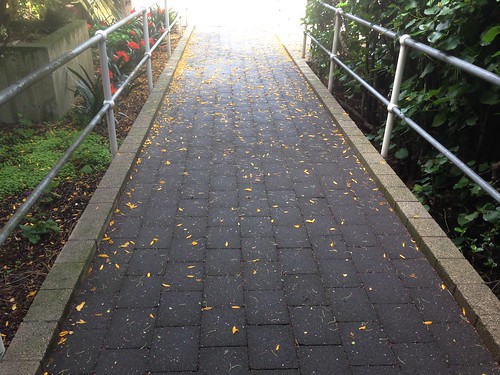
creative commons licensed ( BY-SA ) flickr photo shared by cogdogblog
Knowing the light was very bright at the end of this ramp suggested to me I could create a suggestion of moving into a mysterious zone. This was all about knowing how this light would work with the darker tones of the foreground. Contrast is your friend in photos (and ideas too).

creative commons licensed ( BY-SA ) flickr photo shared by cogdogblog
In teaching visual creativity, I ask my students to look for the use converging lines as one of those patterns they might pay attention to. In a photo they work incredibly well to give depth, or suggest where the eye should go. This cattle guard off of the Beeline Highway in Arizona does not get interesting until you get a low angle in it and tilt the camera to get that convergence. And the rusty patterns give it texture.
Shifting perspective, need I say more? Looking for how things converge just by changing a point of view, relevant in information sorting? Yup.

creative commons licensed ( BY-SA ) flickr photo shared by cogdogblog
And sometimes you just have to have experience knowing what makes the light work. Pointing into the light, using a lens with a wide open aperture, a background with point light sources– voila, loving the bokeh effect. I knew what would likely happen if I focused on the poppy in the front using a wide open aperture settings. It’s not accidental, but also knowing my tools does not guarantees success. In this case, experience is my guide, but sensing the light draws me to try it out. It does not always work, but each time it does– reinforces the process.
The same thing for idea sensing- you get better at it with practice, and knowing/refining the tools you use. Again and again and again. But not just by some sheer 10,000 hour Gladwell drum banging monkey, it’s the practice and the reflection on practice that matters.
So… am I just stretching? Or showing off photos? Again, the approach of thinking about my photo approach, and then thinking about it again in reflection works as a process to refine my ideas. It’s not a matter of being “right” on a subject or touting your book/article/etc, it’s abut a practice of the mind.
What kind of light do you see?
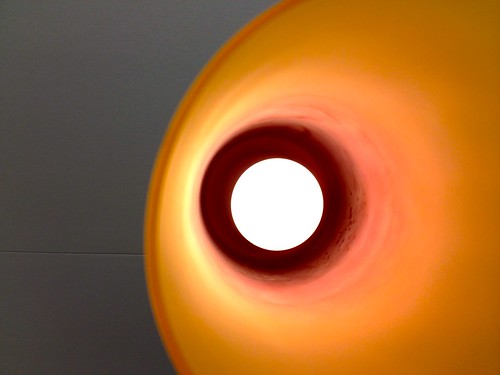
creative commons licensed ( BY-SA ) flickr photo shared by cogdogblog
Well Done as always Alan. Even though you are talking about techniques you should also mention the importance of tagging you photos and creating great titles for you photos.
Well done and great post. I could look at your photos forever. Love the Arizona Blue Sky!
Superb, and bookmarked for reading 2ce more.
(Also this hour : https://connectiv.wordpress.com/2014/10/27/talking-about-art-some-dimensions-and-keywords/ ).
I love the specificity of your critical awareness coupled with vivid illustrations from your own eye/hands: !!!
In my upcoming course on Creative Critical Reflection, this is a key area I’m going to spotlight: what models/paradigms/exemplars do we each have for our scholarly work, our non-academic work, how are they nonseparate. And how can we mobilize our fine everyday habits ( cooking, gardening, sewing, photography, woodworking, ) as critical benchmarks for how we receive as well as produce, in other areas. Hopefully, for one thing, this will ameliorate the challenge of a disseratation, ( text means weaving ), but also serve to make the process ” integral ” ” transpersonal ” ” transformative ” … We’ll see.
( Have you noticed “Contemplative Photography” is now a field of study ? )
You’ve refined my perspective, amplified my awareness, & illumined my vision by this recital. Thank you
My own ‘standards’ include haiku & cinema, musical composition ( which I appreciate but don’t personally do ), open water swimming, & Zen …
Thanks Gary, this was really just a single idea floating in my head (can I connect the feeling of seeing light to the information flow?) tried out as a thought. I’ve seen others write about this act of going about noticing the world helps them find focus, balance, it might even be thought of as a quasi meditative practice.
I’ve not heard o Contemplative Photography but am off and looking. Where is this info on your course? Would like to see that.
As with any really good Post the comments here are no less vital — so thank you again Alan for prompting this wonder-full flow
Painting with light, Sandy, is the title of a book by a wonderful cinematographer, John Alton.
Contemplative Photography is new to me, but not surprising, in part given the ubiquity of the apparatus these days. Minor White, earlier Steichen … Imogene Cunningham … then, there’s Minor White’s student John Daido Loori, for whom photography was a Zen koan … showing your Original Face ( your face before your father or your mother were born ) …
QUESTION: I like how you phrase your response as your *feeling* for light ( which is what makes it art ? ) … :: do we ever SEE light herself, or only refractions / reflections ?
Would be curious to know too if you have any citations/links for other writing about “noticing the world … finding focus/balance” … me, am keen on Goethe’s delicate empiricism, which involves seeing as an active participation in nature & Her forms … and also my mindfulness practice ( in the tradition of THich Nhat Hanh, btw ) … but no matter .. …i do love the “theme & Variation” trope underlying the form of this post, Alan, and how it allowed so much of your experienced seasoned perceptions & insights to just seemingly spill in a shapely Coherent performance … ( maybe it took 12 revisions, but if so that doesn’t show ) …
My class? where might I post a syllabus in-progress ( on say the #ccourses campus ) — for questions comment criticism ( wiki ? ) … ‘cos it’s a class I was assigned that hadn’t been taught before at http://sofia.edu, where I’m (bran-)newly appointed adjunct faculty, and am the newbie in the #ccourses course too, who’s learning here about how to create an aggregated hub in wordpress & such-like, from scratch …. hey, i’m a model experimental subject …
Anyways, please let me know too if there’s any fee ( you own your own words ) or required permissions attribution for when I use this post as curricula in Creative Critical Reflection … ( i know, it’s a gift economy, but within the shell of one that ain’t, so I’m just sayin’ ) … it’s a honey of a piece … as I don’t need to tell you by now
Thanks
Hi Gary, I am just back from my rabbit hole of trying to find some resources, likely ones you know.
But first, yes, of course we never see light, we see its refractions, or what is reflected to our eye, and what we forget from our cursory intro to optics about color we see as being the negative (or leftovers) from the energy not absorbed by a subject. Oh another metaphoric slide there.
Perhaps a better phrasing is “sensing light”?
I did a talk a few years ago on “Looking Thru the Lens” trying to make some leaps from the principles of photography (aperture, shutter speed, ISO) to learning:
http://cogdog.wikispaces.com/thru-the-lens-2013
and have been adding some resources irregularly to https://www.diigo.com/user/cogdog/thruthelens
I’d super highly recommend digging into Jonathan’s Worth materials for his phonar course (Photography+Narrative) http://phonar.org/
My friend/colleague D’Arcy Norman wrote of a concept in photography you will find in many places of “Mindful Seeing” http://darcynorman.net/2008/01/09/on-photography-as-mindful-seeing/
There’s classics I really need to actually read in depth that others have clued me into. First is Susan Sontag’s On Photography. I kind of like that my PDF is obviously from a print scanner (I can see the cuff of their sweater as they were pressing the book against the glass:
The other, quite longer is the book based on John Berger’s BBC series “Ways of Seeing”. I find the ideas in these rather older works to be even more relevant now.
Finally, “Fees? Fees? You don’t need no stinking fees” My words are really others, all my stuff I have made a point to give away (there is a creative commons thingy at the bottom of my posts), and a link is more than enough feed.
Hey you’ve generated something like an alphabet of responses now ( 24 ? ) & more to come.
I appreciate these comments & your hosting them as much as the inciting prompt … & am grateful for yours to me. ” Feeling for light ” is just right.
To respond in kind, if not degree, with some sharings:
besides John Daido Loori ( may his memory be a blessing ),
https://www.youtube.com/watch?v=VPR_5MvFIXU …
I’d also commend Stephen Batchelor
http://www.stephenbatchelor.org/index.php/en/photography-and-meditation — as a good ally in the in-sight vector of deep seeing … being & seeing … etc
&
in the John Berger vein, a film :
http://www.imdb.com/title/tt2268732/?ref_=fn_al_tt_1
When I saw it in theatrical release, its senses of space & placement were naturally in-formed by the theater itself, but even watched at home ( streamed ? ) it would still convey much of its vision, which might bring a smile
Gee, I gotta add a postscript to these mere citations that your work, as art, is of such depth that I could not begin to even scratch it with the merest words of criticism.
Will immerse further in the links you proferred, as I unearth myself …
_(())_
I think it’s great to show off photos, and I think it is always interesting when artists talk about their passion.
I am, myself, passionate about “painting with light”:
vimeo:///videos/109832275
But your intriguing Question of the Day is how those of us who may or may not have a longer attention span than a guppy sort the ocean wash of the internet.
I think for me it is having a stronger interior world than exterior. I feel creatively led in my explorations by the Dreamer Within. I have my evolving lifetime interests, and I tend to recognize key words as the digits stream past.
I always wonder why I can’t find more people as interested in actual digital storytelling as I am? I’m not inventing the genre, so I often ask myself if there are key words that every other passionate maker of little personal documentary films is using that I don’t know? DS 106, as much as I appreciate our little global community, really has no other digital. story video makers in it that I can tell.
So I really wonder what and who is really out there on the net?
But I digress…
That’s an interesting perspective, Sandy, that your own life honed call to creativity helps guide you in the great flow. Does that help with the tendency others feel for being over flooded? And how do you go about tapping in to areas that may be far outside your Dreamer range?
I am not sure what you mean by “actual digital storytelling”; if you mean the personal documentary style of course you know the CDS folks and hopefully who will meet at their conference. I’d think you’ve find more of these in some of the groups or channels in vimeo. I am not comfortable myself in saying what is “real” digital storytelling and ?? To me the media form of the story is not the criteria I sift by.
It wasn’t the name, it wasn’t the title, it was the light that caught my eye.
I was drawn in, colour, form, a stance.
I stopped to catch breath.
The vantage point was sound.
I felt as if accompanied in my reflection.
As I moved down the lines, I became aware that I had left a frame, that I was free.
“Le véritable voyage de découverte ne consiste pas à chercher de nouveaux paysages, mais à avoir de nouveaux yeux. ”
? Marcel Proust
Thank you.
Simon.
Poetic in comments, Simon, I am beyond appreciative for that understanding of freedom in leaving the frame. And amazingly, my paltry relics of high school French got me through your Proust quote, all but the word for eyes. All but the eyes indeed.
No, thank you. Merci gracias 😉
Wow, Alan – love this post. As you know, I’m a great fan of your photographs. I don’t think I’ve created a presentation in the past couple of years that does *not* have one of your CC-licensed images in it 🙂 Your images and metaphors speak clearly to me. I’m not in blue-sky Arizona, but in usually-gray-sky Galway (with roots in big-bold-NYC :). But it’s more than just your images that catch me — I’m struck by your way of seeing, I suppose. So this description of that process is fascinating.
I think there are indeed parallels with how we read and navigate the web. I found your post via Gardner Campbell’s intriguing tweet:
[Looking for Light/Looking for Ideas bit.ly/130iB4P > mind, attention, perspective. Outstanding. @cogdog #ccourses #thoughtvectors]
How much happened in the fleeting moment that I read that tweet? — my trust in both you and Gardner, grown through our connections over time; my attraction to notions of “light, ideas, mind, attention, perspective”; and more? This level of attention, filtering, purpose, trust… it’s fascinating. And it is what I try to help students to reflect upon and practice when I work with them — what the useful (but perhaps limited?) concept of digital literacy leads toward.
You’ve left me thinking, clearly!… thanks, Alan. again 🙂
p.s. one of my favourites of yours – cover image here 🙂
http://www.slideshare.net/cicronin/ed-tech-2013-keynote-slideshare
As much as I relish my blue skies I’d love to see the gray of Galway. I’ve pondered before the idea of a photo shoot challenge of taking people to a non-descript location and asking them to find the beauty there through the camera (I did try it with the folks who work with Chris Lott in Alaska, we went to a place where people drop of unwanted household items).
And it truly ripples back when someone even sees a meaning or connection in your own photo, s sort of sideways shared seeing. That look out the door was certainly one where I felt “something” was there but it did not reveal fully until I was editing the photos.
When you come to Ireland, Alan, I’ll bring you to the Flaggy Shore… very near my home. It is a place of infinite beauty, changing light and colours even on the dullest days. Would love to see your images of it 🙂 https://www.flickr.com/photos/catherinecronin/sets/72157638079463744/
Seamus Heaney described his visit to the Flaggy Shore, “a hurry through which known and strange things pass”, in Postscript: http://www.smith.edu/poetrycenter/poets/postscript.html
I love all your posts, but this one really rang the Big Bell for me. Simon’s quote from Proust is right on the money. Here’s one from Blake: “If the doors of perception were cleansed, everything would appear as it is, infinite.” And Douglas Hofstadter writes about our ability to generalize, to put frames on different places in the repetitive sequences we see around us so that we can begin to see patterns. You not only see those patterns, you share them with a soulful and thoughtful intensity that is truly unique. I feel very lucky to know you.
I’m not quite sure I want my perception doors that cleared! Perhaps its in its lack of seeing the infinite we have the joy of discovery.
And you know that luck is more than mutual.
Well, that’s not exactly what I meant–I don’t think Blake meant that either. So let me try again. If the doors of perception were cleansed, we would never look at anything and say it’s “just” a thing, a this or that. Instead, we would understand that there’s an infinite field of joy, wonder, and discovery open to us even in apparently inert or humble, quotidian things.
The idea isn’t that we would immediately see all there is to see. The idea is that we would see that there’s an infinite world to explore even in something that seems quite bounded and ordinary.
Is that better? I chose the quotation because it seemed exactly to align with what you’re saying–and by saying and showing, doing–here.
That is, not seeing the infinite, but understanding that there’s an infinity there to explore.
Or SEEING that there’s an infinity there to explore.
OK, Alan — 24 hours in and this post is becoming it’s own MOOC 🙂 Many thanks for starting this amazing conversation, and thank you all for sharing your thoughts so beautifully. Steichen, Goethe, Sontag, Berger, Proust, Heaney and Blake… I thought I was revising a paper this afternoon but I am now imagining “painting with light”, pondering new ways of seeing, and being. and stopping. stopping to consider Gardner’s reminder of the infinite in each humble moment. The joy of learning like this… thank you all.
“…and catch the heart off guard and blow it open.” – Heaney
can I just say that I’ve been tweeting and blogging about your post and just NOW realized that I had not read the ENTIRE thing? I was reading it on my email and I thought it ended like halfway up there before that wonderful wonderful list of photos with your commentary afterwards.
Love your photos and your blogposts. More responses to you later on my blog and after reading other people’s comments 😉
Good lord
Your photos made my night.
Thank you for sharing the gift of light …
Kevin
As usual you mention a lot of good ideas and points. I like what you have last mentioned that good photography comes from practicing your mind. I do not know much about Zen, but it reminds me on it.
It also agrees with ideas I have about practicing the mind, that is you can transfer your achievements to other areas, even to completely different once. Many kids who have music lessons for example are very good students.
Another interesting point for me was to read about finding ideas in the web. Strangely enough I find many good ideas in really bad photographs in my flickr steam. They are like sketches. The nature of sketches is to find ideas you have to refine. Normally we do not share our sketches, which no one can admire, but I am grateful some do.
Still, your stream is valuable to me for other reasons. Like you have a sense for what might become a good picture by following your intuitions or emotions, I have a sense for what is a good and enjoyable picture. Only your many sign images when you are travelling I can not understand.
I like that idea of bad photos being sketches or maybe unfinished ideas. Maybe that’s what the signs are 😉
Alan – such great parallels drawn here. As someone who is also passionate about photography, I have found that the deeper into that realm I go, the more I see the world differently. I see photos (opportunity) in everything. I drive my kids crazy sometimes, pointing out the things around us that they take for granted and describing why they would make such great photographs. You learn to appreciate all of the detail around you. From that perspective, I see even more how important it is to surround oneself with those who see things differently – diversity of ideas and experiences. Education is very much intended to be about this.
The best photography tip I every received early on was one that you mention here… to always bring your camera, because you can’t take photos of interesting things if you don’t have it… and not bringing it with you removes some of the habit, urgency and passion in looking for interesting things.
The lenses through which we see the world are so critical. Some have only prime zoom lenses while others have only wide-angle ones through which they see the world. A variety of lenses which allow for diversity of views and vantage points through which to see and understand the world is so important. The other tip that I have put into practice is to force myself to use a variety of lenses for periods of time, as it is too easy to get comfortable with a single lens. Rather than using that telephoto lens that allows one to conveniently zoom in or zoom out as needed, sometimes sticking to that 50 mm or 200 mm prime becomes the inspiration needed to look for (and discover) new things that we would have missed had we had the convenience of just staying in the same place and zooming in our out. Having to physically move closer or father from subjects can help us uncover new things.
Anyway, thanks for stirring up even more thoughts with this post and ensuing comments!
Thanks for the ideas and co-photo habit sharing, Steve! The lens tips are things I have tried. I once went to the Grand Canyon and dropped my camera in Flagstaff, breaking my trusty nifty fifty, so did the whole trip with my 10-20 wide angle, and I also have tried the just going out with the 300mm one. It does force you to try new things.
And as much as I agree with the Worst Camera is the One You Do No Have, I can also appreciate times when I am about and just acknowledge what I see might have made a great photo w/o taking it, kind of like taking a mental photo. I am looking out a window how at some brilliant light on trees in front of a dark mountain. I can see thats one that calls to me… will I take out the camera? May— SORRY GOTTA GO!
I like the comment about lenses too since there’s the obvious extensive implication, what lenses / frames do we use in perceiving, understanding, interacting with reality.
Remind me, ( p l e a s e ), since it’s touched a button so wide in me ( & others ) —- what was your inmost intention / aspiration / purpose / motivation in creating this post …
… & cld you speak just a bit about the actual process of its composition ( you’ve already alluded to some of its ‘influences’ ): did it have an outline in pencil on the back of a napkin, is this the 12th draft, … did the photos inspire the ideas they illustrate or vice-versa, or … both / and, etc. ( You’ve just a Nobel for this piece, and I’m an interviewer for Time magazine, if that makes it any easier ) …
& gosh thanks …
onwords, & upwards …
Hey Gary,
Talking about the intent of the post in hindsight of it striking a response in others might make me strive for a grandiose tale. So I have to say it was merely trying to put into words a feeling I’ve recognized in looking at the world through a camera. I have done a daily photo posting project since 2008, and have had an awareness of many times I have been in a place, often nothing terribly noteworthy, where the light seems to be very powerful in either intensity or contrast.
I cannot say that I have a grand skill of pre-visioning photos, the reaction to light is a hunch, and might be off as much as it is on. My favorite part of the process is the evening review of photos (which I get to do after writing this comment). Nearly every time, I notice something then that I did not see while composing, or the photo I thought would be good is not as good as another. Or one that I felt that light speaking did turn out to be beautiful. I tweak almost every photo I publish, usually minor- a lot of it is just cropping or some boosting of the blacks. The lens, my favorite the nifty fifty Canon f/1.4, often seems to pull out things my eye does not see.
I live in a place (north central Arizona) where there is a lot of light, often very sharp. Currently I am in Kamloops, British Columbia, and having just arrived, trying to get accustomed to a place I will be a few months, I am taking in a lot of detail. I am living overlooking a valley, and have noticed especially in the evenings some moments (on mostly cloud days) where the last light really breaks through with vivid detail on the city or mountains beyond– like this photo https://www.flickr.com/photos/cogdog/15452409700/
My ideas for blogs often come away from the computer, while driving, walking, in the shower 😉 but I just wondered if this idea of a hunch in noticing and paying attention to light was possibly a metaphor for ways of thinking about the online world of ideas and information. In light of being part of Connected Courses (http://connectedcourses.net/) and similar ones before where people describe being overwhelmed by messages and content, I wondered if developing a sense of hunches in that space was helpful.
I don’t do notes for posts (unless I am on a long plane trip) and as my typos/grammar faux pas might demonstrate, I am not big on drafts. I nearly always write and publish in one sitting. So it stated with the writing, except for the lead photo. I do not proceed with a post until (a) I have a semi-clever title and (b) I have a opening photo (usually someone else’s creative commons licensed photo).
I searched my own flickr photos on “light” and that image in the stairwell at VCU stood out because of a few comments on it. I remember that it was one taken really on impulse (I was walking down the steps with my friend and colleague Gardner and we were going to dinner), and was just done with my iPhone. But I remember looking up and feeling like there might be a good photo there (I added some punch with the Snapseed app).
So it just came out in the order as written. I knew I wanted to illustrate from my most recent photos (I could have gone way back, but I did not feel like doing that much research), so I just went through my flickr stream and opened about 15 in new tabs as potential subject/examples.
At first when describing the images I just wrote about what I thought I was thinking when i took the photos, but as I wrote, I did go back and fill in the questions, thoughts about relating them to the ways I might thinking about the same process in idea space. So its mostly stream of consciousness, but I do go back sometimes to thread it together. It’s a bit of keeping some continuity to a plan that was more formed by the time I was writing then before.
I’d say this was written in maybe 90 minutes, sitting in the Common Grounds student run coffee shop in the Thompson Rivers University Campus Activity Center. I like this space because there are tables where I can look out at those same mountains and light.
Whew, this comment is almost a post in itself. I really write for myself, it feels good, and helps me process what I am experiencing. I am not writing in search of an audience, but when people do respond like they have for this one (this might break my record for comments) it’s a great bonus.
Now about that Nobel prize….
What a splendid post. It’s a lesson for me on how to take photos.
I’ve been training my instincts over the past couple of years, thanks to the generous help of you, Alan, and other pals. To answer your question, I sometimes look for strong colors, like a suddenly sharp blue of sky against white birches.
I also look for spaces with a single interesting object in them.
This is so different from how I think about writing.
ok i’ll take the bait & say I’m waiting for the other shoe to drop, Bryan [block that mixed metaphor] :
How do you think about writing ?
I like that metaphor mix.
To answer your question, I need to write some blog post on my end. Too much in my brain.